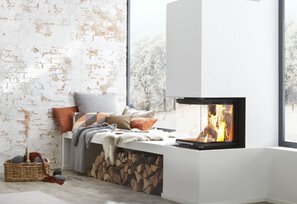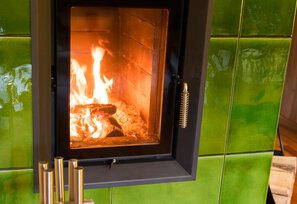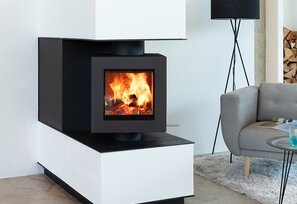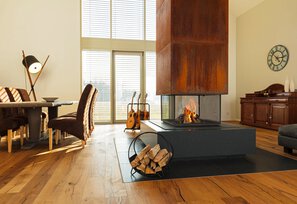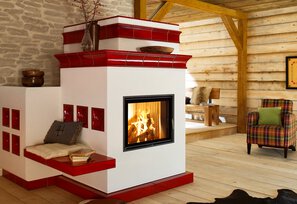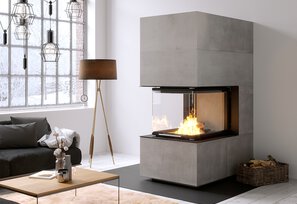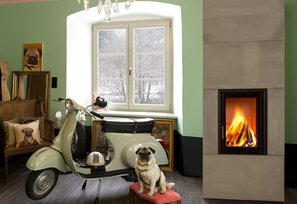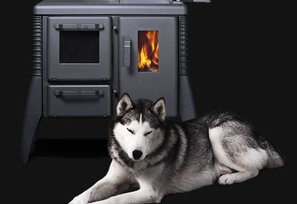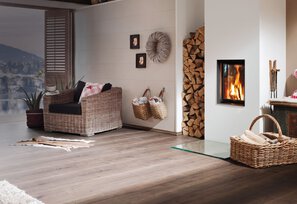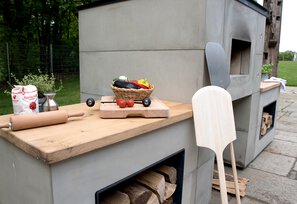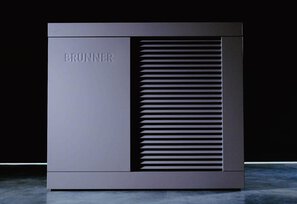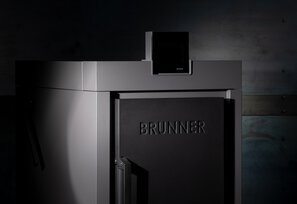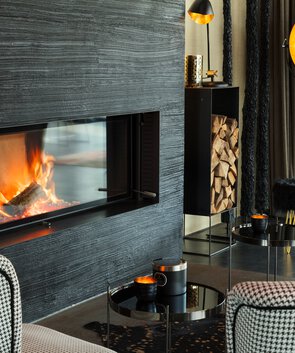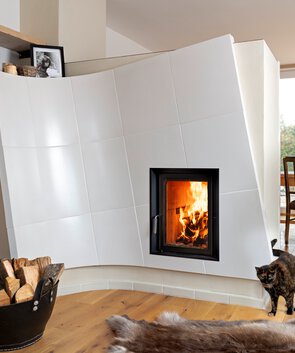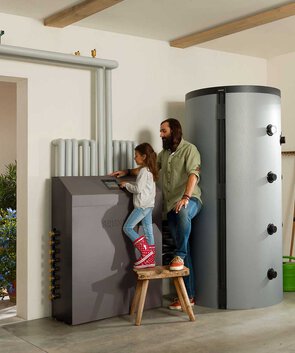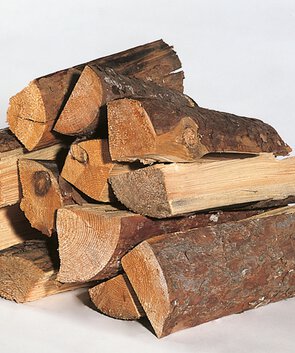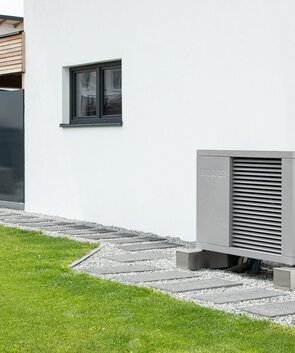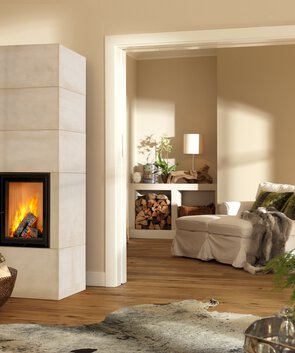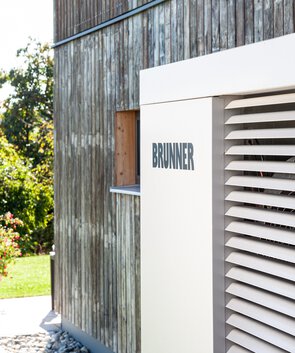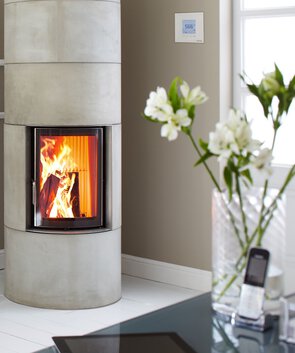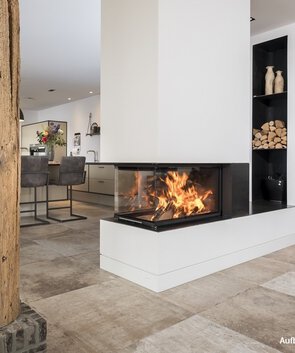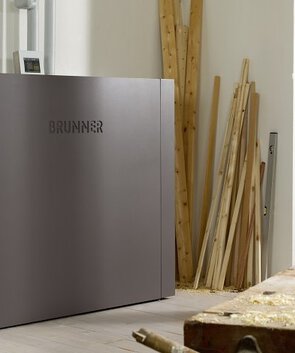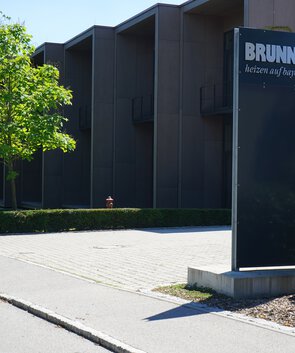Tiled stove, fireplace, wood stove
What’s the difference?
Whoever has already dealt with the topic of fireplaces has certainly stumbled across a number of stove and fireplace versions and designations. What's more, the devices all look almost the same: Everywhere there is a heating insert, a viewing glass and behind it a crackling fire. But how are you supposed to tell whether it's a fireplace, a wood stove or a masonry heater?
We'll explain briefly and simply what the biggest differences and advantages of the different types of device are. Let's start with the most well-known wood fireplaces:

Tiled stoves
The tiled stove has been considered a very popular source of heat for centuries. In the past, tiled stoves were mainly installed with tiles, as these are very easy to clean and were an expression of taste, fashion, but also a status symbol at that time.
In the meantime, other materials such as metal, bricks or plaster have proven themselves for the design of the outer shell in addition to tiles. Due to the different materials there are many design possibilities, for every tiled stove an individual planning is necessary and makes it unique.
Tiled stoves are also called masonry heaters, radiant stoves or storage heaters. Although they may differ somewhat in their operating systems, in all of them the desire for warmth is paramount and the underlying mode of operation is always the same:
As the name masonry stove already indicates, the fire is not lit on a grate but on the bottom of the stove. The heating gases produced by the burning wood flow through the storage built inside. The storage material stores the heat energy contained in the gases and releases it into the living space over several hours. This principle results in high efficiency with maximum energy yield and low emissions. We have summarised exactly how this works in this video:

Other tiled stove versions based on this principle:
- the hot air tiled stove/ hot-air furnace
Hot-air stoves give off hot air to the room in addition to radiant heat: Cool room air that flows into the inside of the stove through the base openings is heated on the outer walls of the heating insert and rises upwards in the stove. The hot air returns to the room through a ventilation grille. At the same time, the heating gases from the stove insert heat up a reheating surface, whereby heat is released quite quickly in the form of hot air.
- the combi-tiled stove
This type of stove also emits both hot air and radiant heat. The difference to the hot-air stove, however, lies in the reaction speed: the heat energy from the heating insert flows across the interior storage and thus takes considerably longer to give off radiant heat to the room.
- the hypocaust stove
The hypocaust stove has an additional closed air circuit which only circulates inside the stove and heats the heat storage and the tiles. The outer shell gives off the heat over large areas, often over two storeys. However, this type is hardly ever installed today.
Open and closed fireplaces/"Urfeuer”
Fireplaces usually primarily address the desire for atmosphere through visible fire.
Basically, two types of construction can be distinguished: Open and closed fireplaces.
An open fireplace creates a romantic atmosphere and a genuine "campfire look" in the living room. However, it is important to know that this type of fireplace allows a large amount of air to flow outdoors via the chimney due to the free cross-section of the fireplace opening. Thus the open fireplace is to be seen as a "room ventilation system" when it is burning and is therefore less suitable for heating.
For houses with older construction methods, these fireplaces are not an issue, as sufficient air can reach the fireplace through cracks or other leaks. Today's denser construction lacks this natural air supply, so an artificial air intake duct must be built to the fireplace.

The situation is different with heating fireplaces or closed fireplaces, which are equipped with a transparent stove wall (ceramic glass). Ceramic glass are still a fairly recent invention, having been around for about 25 years, and they made the closed fireplace possible in the first place. Due to the closed firebox, the fireplace now functions similarly to a stove, but only has a "satisfactory" efficiency over a relatively small reheating area.
The closed fireplace is ultimately characterised above all by the fact that it only draws in the air supply needed for the burning process. These fireplaces are primarily designed for fire atmospheres with heating power and rapid heat release. With regard to the appearance, a great deal can be realised, from various shapes to 1-3-sided glass doors.

Gas fireplaces
A gas fireplace is the ideal solution for anyone who wants to (or has to) do without heating with wood and everything that goes with it. Sometimes, for example, living conditions make it difficult to heat with wood; a person in the city living in a small flat on the 5th floor will be very reluctant to put up with storing and carrying up logs.
The fuels natural gas or liquid gas make it possible to enjoy a fire in a very clean way. Thanks to deceptively real, ceramic imitation wood logs, the gas fireplace can now hardly be distinguished from a real wood fire. Press the button, light the fire, adjust the flame size and enjoy. It couldn't be more convenient.

Water-bearing fireplaces and stoves
In addition to enjoying the fire atmosphere and heating rooms, fireplaces and stoves can also be used to produce hot water. For this purpose, the heating gases flowing out of the firebox are passing a water-bearing reheating surface. The heating gases give off their heat to the water and enter the chimney at a reduced temperature.
The heating water heated in this way is collected in a buffer tank.
As a rule, more than 50% heat output should be converted into water output. Only then does it make sense to spend the additional costs that this combination entails. This system is particularly interesting for low-energy houses.
Water-bearing heat exchanger surfaces are offered for almost all stove and fireplace shapes.

Kit system tiled stoves
A kit system tiled stove can be compared to the principle of a prefabricated house: Prefabricated components only have to be assembled in the customer's living space by a specialist. This results in the same advantages as with small storage stoves. Within a very short time, an inexpensive stove is assembled and can be used immediately. Kit system tiled stoves s are also available as water-bearing versions.

A small storage stove is a form of the masonry heater, but its compact column shape allows hours of heat enjoyment even on a small footprint. With this version, there is no limit from a round or angular shape in clay cladding to an individually handcrafted cover. The essential difference to the kit system tiled stoves is that small storage stovescan store more heat due to their storage with heating gas flowing through it.
Further information on small storage stoves in this video:
Kit system fireplaces
Kit system fireplaces are particularly suitable for those who want to save money and time and who need heat. The viewing glass allows a pleasant radiation from the firebox, so that warmth and a feeling of well-being are quickly established in the living room. After the fire has burnt down, it cools down very quickly. Small spaces are no obstacle for this fireplace.

Wood stoves
Wood stoves, Swedish stoves or also called room stoves, are already assembled on delivery and only need to be connected to the chimney for commissioning. A wood stove can be made of various materials: steel, cast iron, ceramic or stone cladding are typically used.
Another advantage of the space-saving stove is the rapid spread of heat in the living space. For this reason, this version is often used as a "transitional heating system" in autumn or spring or also as a "safety system" for heating failures. However, the danger that rooms can quickly become overheated should not be underestimated.
Wood stoves can often be found not only in specialist shops but also in DIY stores in various price and quality classes. However, an inexpensive version should not necessarily be the main focus if many years of high-quality fire enjoyment are desired. Good quality includes the manufacturer's expertise, high-quality materials and excellent workmanship. These characteristics have their price.
Information on BRUNNER stoves is summarised in this video:


Conclusion
After all these options for fireplaces, it is now clear that there are more or less individual solutions and that the construction of the fireplace determines its heating character. If there are already concrete ideas, these should be discussed with the furnace builder. Suitable craftsmen in your region can be found here.
There are many different factors to consider when choosing the right fireplace. Not only the structural conditions and the heat requirement play a role. Ultimately, however, there is a suitable fireplace for every individual need and every budget.
